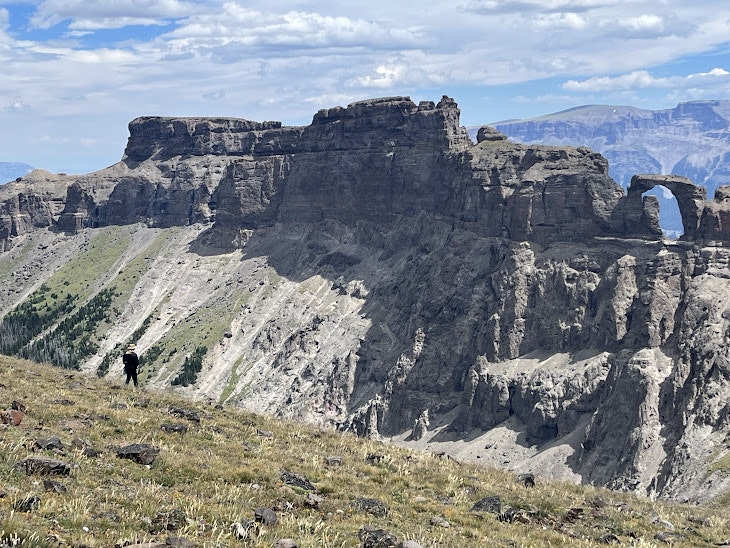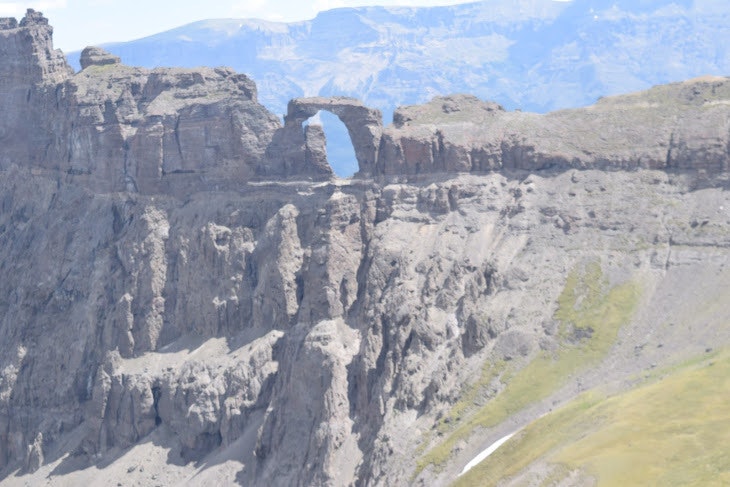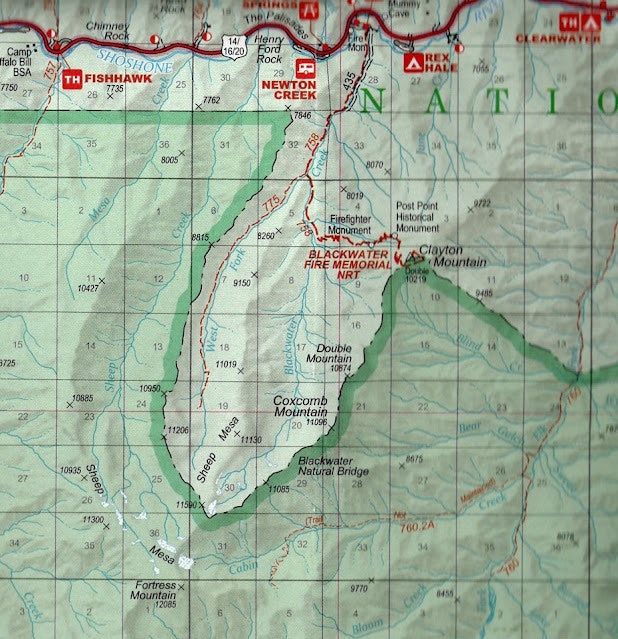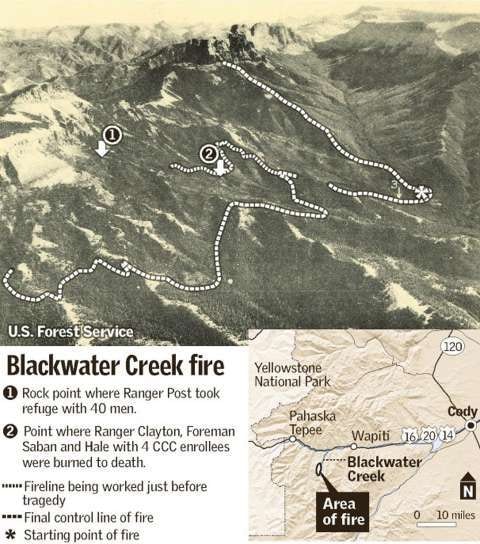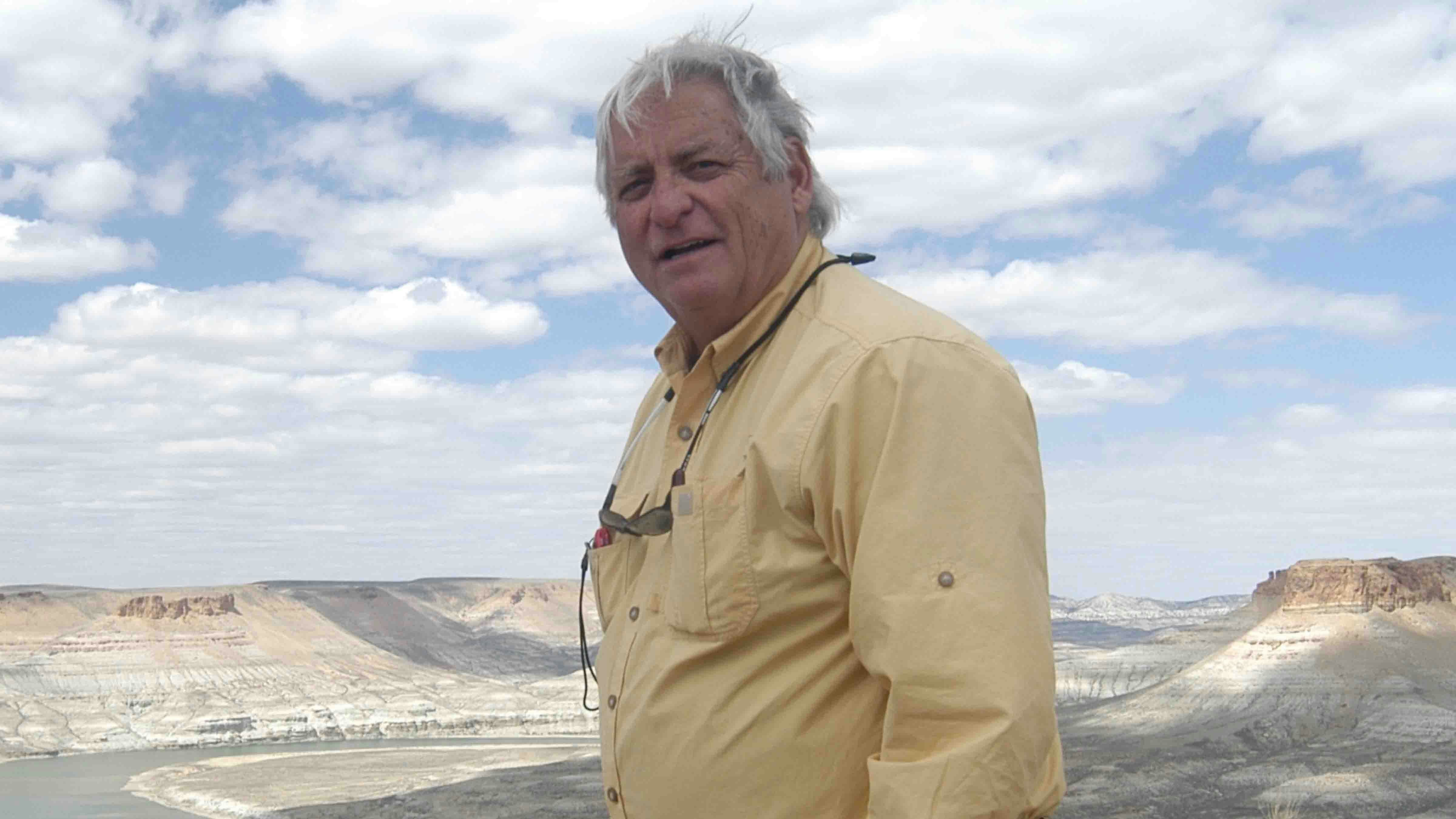In an obscure and difficult place to reach called Blackwater, some 15 Forest Rangers and Civilian Conservation Corps firefighters lost their lives on Aug. 21, 1937.
Lightning started the fire that burned some 1,700 acres in the Shoshone National Forest west of Cody on that fateful day.
This all occurred in an obscure and dangerous mountainous area that features the Blackwater Arch, which for years was considered as possibly the largest natural arch in the world.
My coffee table book, Wyoming’s 7 Greatest Natural Wonders, featured a nice story about that arch by Cody’s Dewey Vanderhoff. Most recently a Lander friend Camille Whiting and her husband James journeyed to the arch after reading about it in my book. Some of their excellent photos accompany this article.
But first, that awful fire.
The Fire Was Horrific
Although the fire began on Aug. 18, it was not detected until two days later and 58 men were deployed in the area.
Lander’s Karl Brauneis is a national expert on forest fires. He cites several changes to firefighting brought about by tragic fires like the Blackwater. The development of a fixed lookout detection system coupled with aerial detection and a system called the Ten Standard Fire Orders all helped keep fires smaller and safer for the men who fought them. Karl told the following about the fire:
A weather event called a “dry cold front” was instrumental in the fire blowing up and engulfing the crew that died. Nine men died immediately and another six died later of their massive burns.
Karl reported another 38 men suffered burns and other injuries as almost the entire crew was injured or killed in the conflagration. Other factors that lead to the blow up included the long-term drought of the 1930’s, the heavy fuels on the fire’s steep north slope, spot fires, a ragged or under-burned fire edge and the traditional large river drainage that will focus and intensify wind currents, according to experts he talked with about this event.
The cause was later specified as an undiscovered “hot spot” which was rapidly expanded by this weather condition that can move into an area so fast. Back in 1937 the Forest Service did not have access to the present-day Fire Weather Warning system that was developed later by the National Weather Service, Karl said.
The 1939 Smokejumper program of fast aerial initial attack by parachute was in direct response to the Blackwater tragedy. Soon a very aggressive system of prevention, detection, and control was in place nationwide. Karl laments the loss of so many fire lookout towers in recent years and believes that many should be rebuilt to help provide for early detection.
He recalls how every ranger was a trained firefighter and job one was fire suppression. According to Karl “it was deep in our culture … every forest ranger was a firefighter.” He says because of trained smoke jumpers the response time to fires stopped a lot of fires almost immediately before they could become raging infernos requiring hundreds of firefighters, helicopters, and slurry bombers.
“I remember once flying in the old DC-3 with 16 of us smokejumpers over the big timber of Oregon. We would circle around the lightning storms and as soon as the storm moved on, we would pick up the fires. We would put two jumpers here, four over there and six on the next one until we jumped out the entire load. Almost all of us would be hung up in the trees right next to our fire. You would rappel down from your parachute and within minutes you were building a fire line.”
But the key to restoring successful fire-fighting today, according to Karl, is the starting up of the national federal timber sale program. “Federal timber not only provided for American jobs and reduced fuel loads but also paid for school districts, county roads, and bridges and most importantly, the large Forest Service crews that planted trees, piled brush, and built trails. Those crews were all financed by the timber sold and were not linked to the appropriated federal budget,” he said. According to Karl, when fire struck, you could put together a 60-man fire crew with the snap of a finger.
As you hike in toward the Blackwater Natural Bridge, the trail veers left to the monument to the lost firefighters. It is at a much lower elevation that the arch.
That Big Arch
Most big natural arches around the world are caused by water and wind erosion. Arches National Park in Utah is the prime example of this kind of arch.
The Blackwater Arch appears to be made of volcanic rock and it offers the most unusual look possible – it looks like an eagle with a snake in its mouth.
The arch is called the Blackwater Natural Bridge in some publications of the Washakie Wilderness of the Shoshone National Forest.
Vanderhoff, who has a background as a surveyor, thought it was 300 feet across at its widest point. Apparently two new arches in China recently discovered are bigger and there are two in Utah that are about the same size.
This arch is made up of volcanic rock, which makes climbing it for measuring purposes perilous. Perhaps with modern drone technology, someone will get an accurate reading some day.
The Whitings are an athletic family in Lander and looked forward to their trek to the arch back on Aug. 12.
Camille writes: “My favorite rocks are the ones with holes in them. Blackwater Natural Bridge has now become my very favorite arch of all time, because of the enormous amount of effort that it took to get there. My husband James, my son Teancum, and I set off on the 17-mile hike, climbing in elevation by more than 5,000 feet (over 11,000 feet at the summit). Blackwater Natural Bridge, near Cody, is rumored to be one of the largest arches in the world, although it seems that almost no one has heard of it.
“I heard about it a few years ago, but everyone I've asked - including people who live in Cody - had no idea what I was talking about. I read everything I could find online about it, which was very little. Some estimate it at 280 feet tall - 5 1/2 times taller than Delicate Arch.
“It has never been officially measured because of its remote location and inaccessibility. You know I absolutely love arches, so having such a majestic and stunning arch practically in my own backyard was way too tempting not to see.
Achieving A Summer Goal
“One of my goals for the summer was to finally see this mysterious arch in person, so when James had a meeting in Cody, I knew it was time to make the attempt. We thought it was 14 miles round trip, based on pages from a hiking book that the forest service had given us. It turned out to be over 17 and was far more difficult than we had imagined. Almost the entire hike to the viewpoint for the arch is uphill.
“It took us almost 11 hours to do the hike - a lot longer to get up than to get down, especially after we spotted fresh bear scat and fresh grizzly bear prints on the trail that hadn't been there on the way up. All three of us had bear spray and we kept it handy as we hurried back down the trail, making as much noise as we could. Thankfully, the bears didn't greet us. We estimated that it was a mom and her cubs based on the size of the scat and the size of the prints.
“If you want directions on how to get to the arch, and other details about the hike, you can find them here: https://camillesarches.blogspot.com/.../blackwater...
“It was the most strenuous hike I have ever been on. Especially the last half mile was so incredibly steep. We estimated that we rose in elevation by 1,000 feet in that last half mile.
“It was so worth the effort to get there -- and a once-in-a-lifetime experience -- because I will never do that hike again! But I'm so glad I did it once. And if anyone can tell me how to access the arch from the other side of it, which is on wilderness land instead of Shoshone National Forest, I would be tempted.”
(Note: Some additional photos of the arch from the other side were by Landon Selby).



